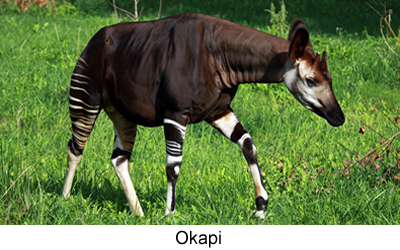 |
|
Name:
Okapi Classification:
Class: Mammalia
Order: Artiodactyla
Family: Giraffidae
Genus: Okapia
Species: O.
johnstoni
Size: 6 feet at the
head, 5 feet at the shoulder. Characteristics:Velvet-like
fur, long neck, short tail, large ears, males have small horns called
"ossicones". Males are slightly smaller than females. Status:Endangered. A reclusive cousin of the giraffe, the okapi is a resident of the dense jungles of the Democratic Republic of Congo. It is so secretive that it was not even discovered until 1901! Its bizarre shape and coloration makes it look like a cross between a giraffe and a zebra. Its dark zebra-like stripes make it easy to blend into the shadows of the forest. Their velvet-like fur has an oily coating that makes it resistant to water. Male okapi are slightly smaller than females and possess small horns called "ossicones". Females are slightly redder in coloration than males. Like a giraffe, the okapi has a long tongue. This 14-inch tongue makes the okapi able to reach vegetation that other animals usually can't. Okapi can reproduce at three years old. Females make a trumpeting sound to attract males. Males compete by neck-knocking one-another. After mating the male and female go their separate ways. Females give birth between August and October after a gestation period of 425-491 days. The newborn is able to stand up in its first 30 minutes of life and nurse after 15 and 30 minutes. While the mother protects her baby, the bond between a mother and baby okapi is reportedly not as strong as other hoofed-animals. Males grow their ossicones between one and five years. Their natural lifespan is not known, but they can live for fifteen to twenty years in captivity. The secretive okapi is currently endangered due to logging and illegal settlements of protected areas. The okapi is also hunted for its meat and skin. A major threat to okapi conservation is the presence of armed groups in the jungle, who poach wild animals and make safe conservation operations difficult or impossible. In June 2012 armed rebels attacked and killed seven conservationists and fourteen captive okapi. Despite this horrific tragedy, conservation efforts for this majestic creature continue. If you want to learn more and join the effort to safeguard these wondrous animals, check out these awesome websites: Okapi Conservation Project-dedicated
to protecting the okapi. ICUN--Okapi page White Oak Conservation
Foundation-An okapi captive breeding project SaveTheOkapi.com--This
website appears to be inactive, but it was created by a 12-year-old
wildlife activist! An excellent example that ANYONE can step up to support
wildlife! |
|
|
|
|
||
|
Contact
Us
|
||||
|
Taproot
Guru © ALL RIGHTS RESERVED
|
||||